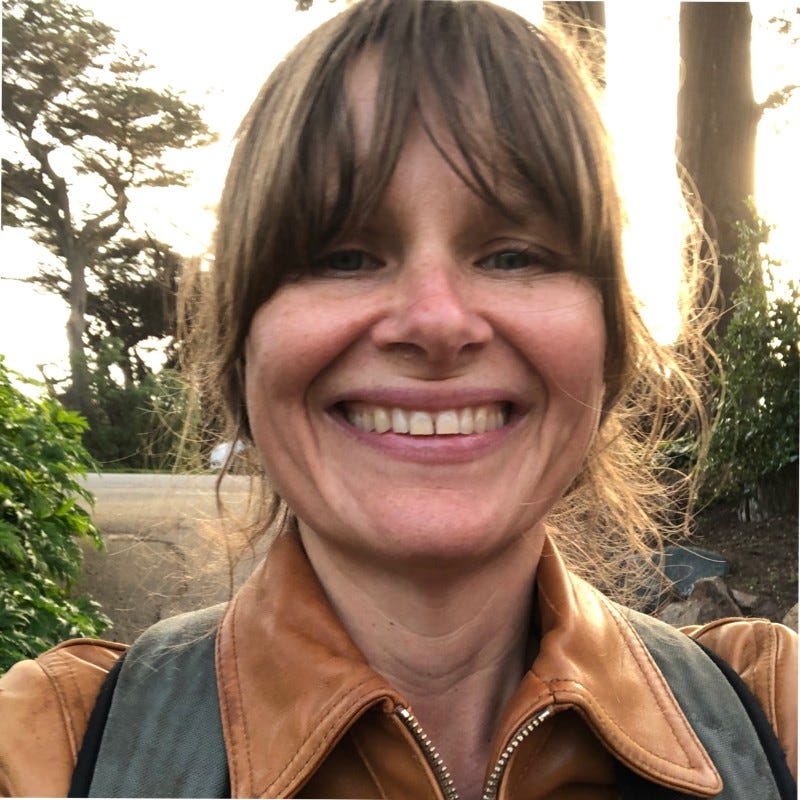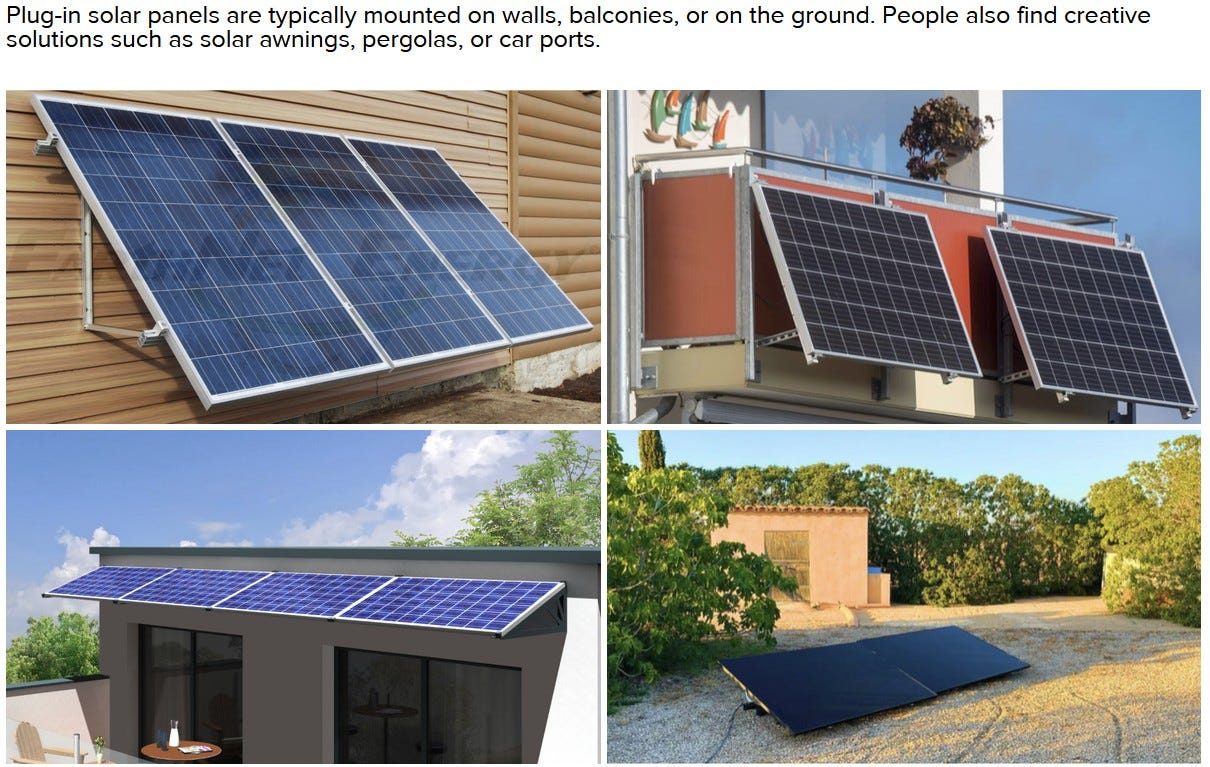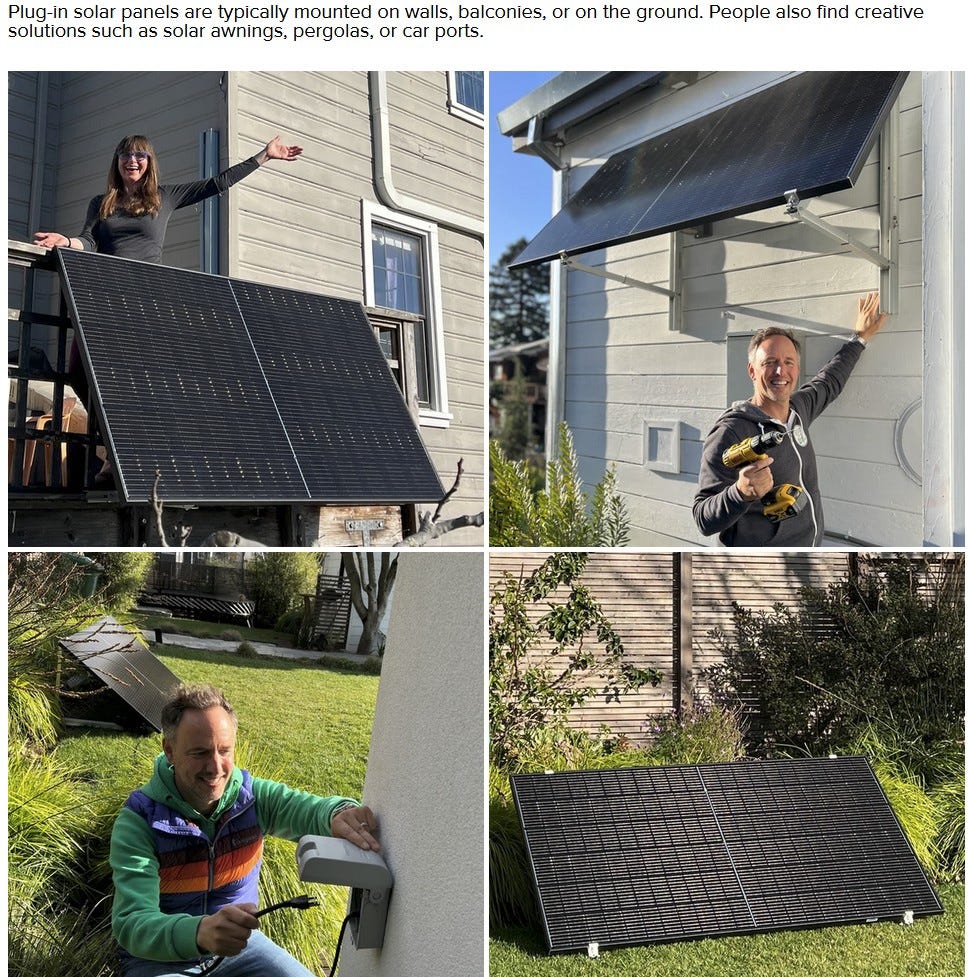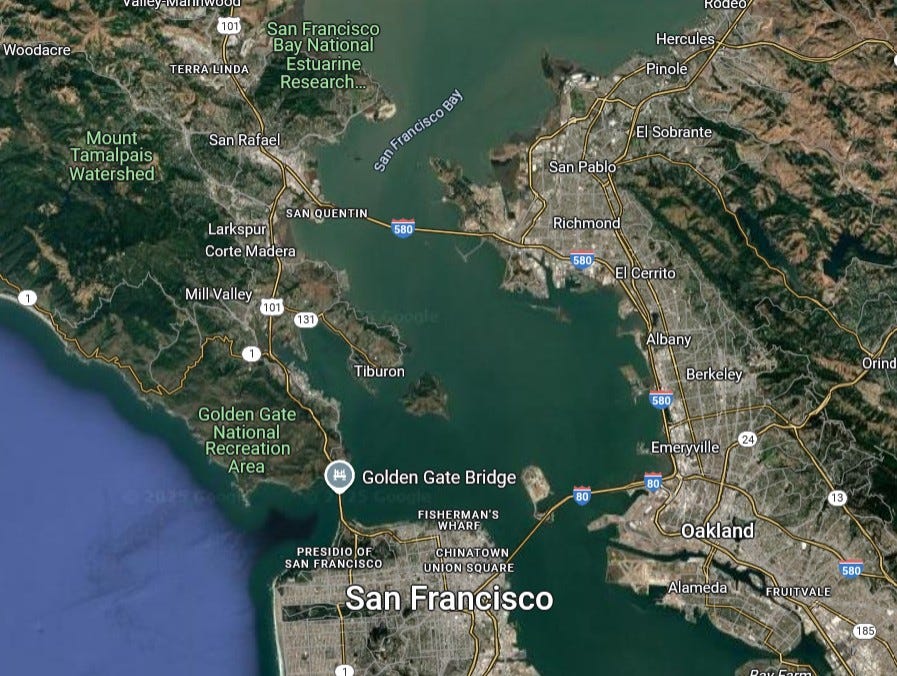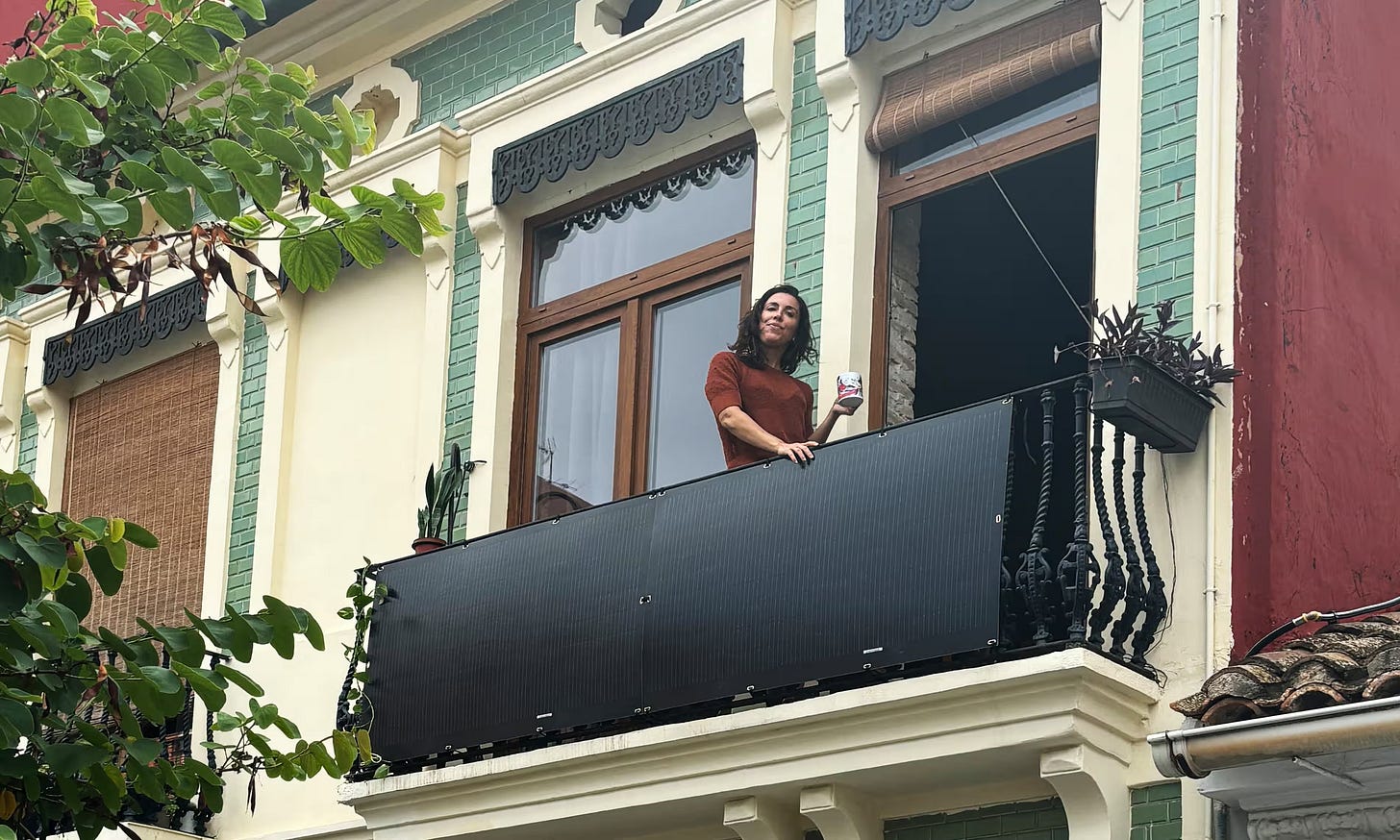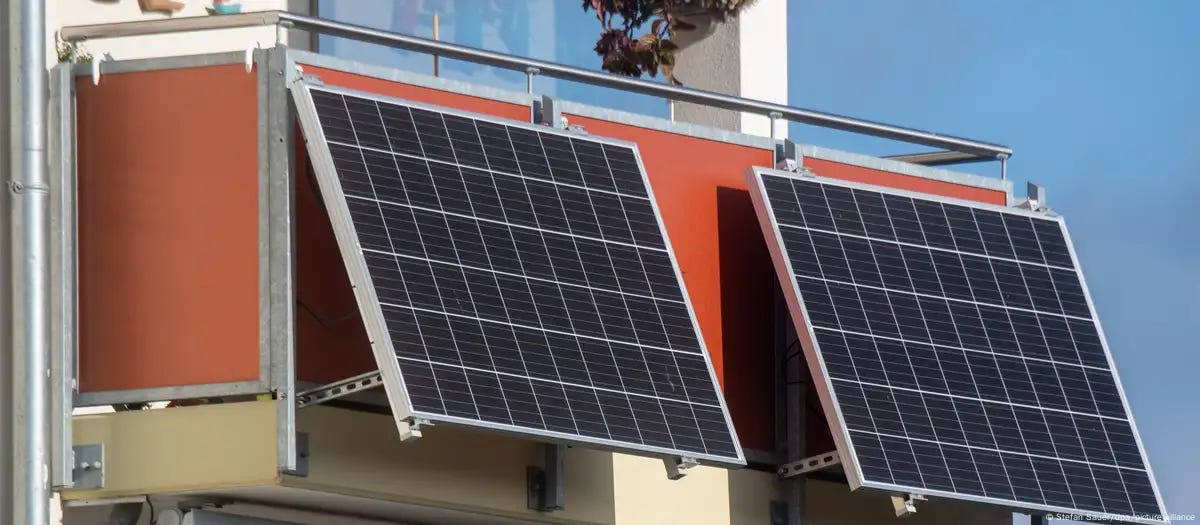[NEW UPDATE] Your Daily Dose of Climate Hope Interviews: Cora Stryker of Bright Saver, Bringing Plug-In Solar to America
Hi folks,
This is a reposting of our recent interview with U.S. plug-in solar (aka "backyard" or "balcony" solar) startup nonprofit Bright Saver, as there's been a time-sensitive update!
To be 100% clear, this is not an ad — Climate Action Now is not getting paid by or receiving any benefits from Bright Saver (they’ve just started and are in startup crunch-time hoping to raise enough money to stay alive!)— this is just a REALLY exciting new idea to rapidly scale up solar in America that’s at a critical viability point right now. Let’s make it happen!
Cora Stryker of Bright Saver just told this newsletter that they've seen an encouraging spike in early sign-ups since this interview was first published (yay!), and they now need to find just 50 more early adopters in the Bay Area of California, ideally very soon, to receive the remaining half of Bright Saver's first 100 plug-in solar arrays and demonstrate the viability of their business model to secure enough funding to continue their work. They’re halfway there! As the interview discusses, Bright Saver is a nonprofit primarily focused on accelerating clean energy progress, and they've structured their subscription plan so that customers are essentially guaranteed to save money by getting plug-in solar.
If you live (either owning or renting!) in the Bay Area, or know someone who does, you have an immediately actionable opportunity right now to save money while potentially becoming one of the few dozen people to pull a promising new clean energy technology across a key tipping point and help move it towards rapid adoption across the United States of America. The link to sign up for the waitlist or book a consultation is https://www.brightsaver.org/contact.
LET'S MAKE THIS HAPPEN, folks! Let's pull this scrappy nonprofit startup across their first finish line and help them stay alive to bring plug-in solar to America!
Cora Stryker is a social entrepreneur and the cofounder of Bright Saver, a brand-new climate action nonprofit working to accelerate the adoption of ultra-simple plug-in solar in America.
In the interview below, this writer’s questions and comments are in bold, Mr. Robinson’s words are in regular text, and extra clarification (links, etc) added after the interview are in bold italics or footnotes.
To be 100% clear, this newsletter is not getting paid by or receiving any benefits from Bright Saver (they’ve just started and are hoping to raise enough money to stay alive!)— this is just a REALLY exciting new idea to rapidly scale up solar in America that’s at a critical viability point right now. Let’s make it happen!
Cora Stryker, thank you so much for joining us today. Before we even get into Bright Saver, your funding model, the effects on households, and so many other cool things, could you just tell me what the core technology is here, what plug-in or “balcony” solar even is? I've written about it a little bit before, but I think it almost sounds too good to be true, and most people still don't know that it's really a thing.
Yeah, absolutely. I do want to get into the “too good to be true” part, because that is definitely a challenge that we're facing as a nonprofit.
So plug-in solar technology has been around for a while. It's been very popular in Europe. It's also called Balcony Solar. In Europe, 1.5 million Germans have it. You've reported on it.
It hasn't come to the U.S. in force for a number of structural reasons. In Europe, you can just order this thing. You can buy it at a grocery store for a couple hundred dollars and you can plug it into your wall and hang the thing over your balcony. Done. Really super easy, and it helps you save on your electricity bills immediately. This became really popular when the war in Ukraine started and energy prices went up pretty significantly, very quickly. People started doing this on their own, and it really has taken off.
Here in the U.S., it's a little different. We’re talking about plug-in solar technology, it is not rooftop, and we are actually really excited about that because there are a lot of people who want solar, but their roofs are not suitable. I talked to someone today who has been trying to get rooftop solar for quite a while, but he'd have to replace his roof completely. Then the price tag goes from $30,000 up to $40,000, $50,000.
Our solution is much cheaper. You could go online and buy one of these [plug-in solar setups] for two thousand dollars, but we really want to serve everyone, so the way we're structuring it is offering it on a subscription model. So the subscription is $29 a month, and for our first 100 plug-in solar kits we’re guaranteeing that folks save that much on their energy bills each month or we reimburse!
We kind of think of this as a gateway drug to climate action because we want to make it really, really easy for people to do something about climate change at no extra cost.
That is spectacular. So you're currently just operating in the Bay Area of California, is that correct?
Yes.
So you're starting in the Bay Area. What are the numbers that you have right now? Do you guys have a warehouse full of plug-in solar kits somewhere? Are you buying them on a customer-to-customer basis? Do you have a relationship with a supplier or a manufacturer? What is the level of supply chain and delivery chain that you've built out so far?
Well, to answer your first question, we have 100 of these arriving here in the Bay Area at the end of March. We are super small. We're at a very early stage. And that's one of the reasons I'm so excited to talk to you, because we’re trying to start a plug-in solar movement in the United States, but we have to start somewhere. No one knows about us. We're brand new. We're about two and a half months old. Right now, we are bringing these first hundred plug-in solar units to the Bay Area. If you live in the Bay Area, or if you know anyone who lives in the Bay Area, we are installing these at no cost, no cost for the equipment, no cost for the installation.
In terms of a relationship with the supplier, at present, there's only one supplier in the United States that we feel has the right safety profile that we are comfortable with. That’s Craftstrom. If the other brands catch up and have enough safety features, we are happy to go with them as well.
In terms of scaling and in terms of your readers who are outside the Bay Area, a couple things. Number one, you could contact people who are in the Bay Area. or post on social. Number two, we would like you to go to our website and fill out the contact us form, because we would love to have a wait list that is really long. That would show our funders that people are excited about this. This is a movement. People want plug-in solar to come here to the United States. So please get in touch, join our waiting list, let us know that you're interested, because we are a non-profit and we have a limited amount of funding to get us to the next stage, which we need to get to pretty quickly.
So what people can do right now is go to the website, even if they don't live in the Bay Area, and try to get on the waitlist?
Yeah, absolutely. And that'll help us in a few different ways. Number one, we'll know where to go next, right? We'll know where the interest is. Number two, it'll help us demonstrate to our funders, and to everyone, that there really is demand for this. People really want this.
And we're honestly the first people to this space, the first organization. We're here early. The question is, Sam, are we here too early? Are people ready for us? We think they are, but we are overcoming some of these structural challenges.
To go back to the earlier question about what's different here, in the U.S. we have a 120-volt electrical system. In Europe, there's a 230-volt electrical system. So we really do need to have a slightly different version of the technology. Because it's so widespread in Europe, there are many suppliers. The price has fallen. That has not started here at all yet. We really see ourselves as the nonprofit that jumpstarts the movement, gets plug-in solar more widespread, ultimately lowers the price and gets this into everybody's backyards as quickly as possible.
This is brilliant. It sounds like exactly what everyone wants solar installation to be, but it never has been so far. You guys could make that happen.
So correct me if I'm wrong, for $29 a month, if you live in the Bay Area now and hopefully elsewhere soon, Bright Saver will send someone with a plug-in solar system in a truck to your house, plug it in, hang it over your garage or your balcony or backyard or wherever you want to put it. And then it will just feed in power through an ordinary plug to your house. And if that does not reduce your electricity bills by more than the $29 subscription per month, they will reimburse you.
That was correct!
In Europe, you don't need an electrician for plug-in solar. Here you do for various structural reasons, so we will bring an electrician and we will pay for it. And our business model, we really believe in sustaining ourselves as an organization. We're a non-profit, we're a 501c3 and we are currently funded by private donations, but is obviously not going to last forever. Our model is that, yes, we do have earned revenue. We do have people signing contracts for $29 a month, but we will guarantee that folks save that much every single month or we reimburse them. And after six years, people will own them outright. so you'll save even more money. You won't be paying us $29 a month any longer.
Wow, that is incredible.
There's a really interesting thing we're seeing around the world where countries are seeing huge solar booms even with no government support at all, maybe not even government awareness, in places like Pakistan and South Africa where the national grid's pretty crappy and people are just buying solar panels because they're a great way to provide cheap electricity for your family.
And sad as that is, the U.S. may be headed that direction in some respects, in that federal support to get sensible things done is being absurdly attacked and destroyed by chaos agents. What's great about plug-in solar is that this is pretty much a pure market solution that does not rely on navigating people through subsidies or regulations and hopefully can happen under the radar and not attract much political animosity.
Yeah. I was just talking to someone this morning about how we are one of the bright spots, pun intended, in the climate change story. In some senses, solar doesn't need federal subsidies to keep going. It can help, certainly, but this train has left the station. But we still can't be passive. We still can't sit back and say, hey, the market is correcting things, this will happen, because that will take too long. In Germany it took 10 years from the introduction of this technology to get to where they are today. It was this slow-burn DIY movement that just got a little bit bigger. The war in Ukraine raised energy prices and it got a lot bigger. In Germany, legislation passed in 2024 protecting renters with plug-in solar from landlords who want to take it down, then it got a lot bigger still.
But as everyone reading this knows, we don't have 10 years to let this happen organically. Bright Saver exists to make this happen a lot faster, to jumpstart it, to help make adoption more widespread, reduce the cost of the equipment. Because if we don't do it, it's going to take too long.
Absolutely. What are the major obstacles you’re facing? Just getting funding is sort of an obvious one, but how about state and local permitting and building code regimes? That can often be a huge problem for innovation in the U.S., there's a whole YIMBY movement around that. Are you running into trouble with states, towns, homeowners’ associations? I'm sure there's tons of busybodies who would want to block people getting plug-in solar. What are your guys' plans for that?
It's a great question. Right now, we're in this zone of “There are no rules against it, but are there rules for it?”
Let me tell you why I mentioned the backyard use case. I'm a parent, I have a little play structure for my kids in the backyard, I didn't need a permit for that. If it's an outside installation in the front yard, the backyard, the side yard or whatever, permitting just doesn't apply. You just don't need to worry about it. Now if you want to hang it over your balcony or attach it to the side of your house, that is a different question. What we believe and what our legal team believes is that it's an impermanent structure regardless of how you mount it, so if there are any permitting concerns, we can remove it right away. Also, we believe that when you put something outside in this manner, permitting doesn't apply.
That said, we are moving municipality by municipality to be 100% sure. For instance, one of my co-founders right now is at the City of El Cerrito permitting office. It's next to Berkeley. We're based in Berkeley, so it's just north of us.
And the reason he's there is because we have someone who's actually a homeowners association condo president, an HOA leader, and she really wants us to be there. She wants us to serve her entire community of condominiums, but she needs to make sure it's not going to violate any permitting regulations. My colleague Rupert is there right now talking to somebody to say, “Hey, look, we believe this is an appliance, would you agree?”
We've already done that with the City of Berkeley. The City of Berkeley Permitting Office agrees with us that it's an impermanent structure. It's essentially an appliance. That doesn't need a permit, like how you wouldn't need a permit to plug in a big refrigerator. But that is something that we're aware of, and that is something that we're eventually going to have to deal with in a less piecemeal way.
All right! So for someone in the Bay Area, because I do have hundreds of readers in California and I'm sure some of them will be interested in this, the first step would be to contact you guys, right?

Yeah! Through our contact form. It’s at brightsaver.org slash contact. On the left you'll see “Book a consultation.” That is just for people in the Bay Area right now. But if you fill out our general inquiry form and tell us where you live, you will automatically get added to the waitlist. Again, that'll help build support for this idea that people want this.
We need to get through this proof-of-concept phase. But then once we get to the other side, as someone said to me yesterday, who wouldn't want this? I mean, it's no cost. It reduces utility expenses. It produces clean energy. You don't need to be a homeowner. Renters can get it. It's really available to anyone!
We just need to get the word out. No one knows about us. That's what we're doing. So if you know folks in the Bay Area who you think might be interested in this, please also get in touch. You can fill out that contact form. Or other organizations! There's also a page for partners.
One of the challenges we have is, as a nonprofit, we don't have a huge runway. We have maybe a couple months to get this party started! And if we can't do it, it's gonna be hard to keep going. Our belief is that, “Who wouldn't want this?” so we just need to find the right folks and get it out there to early adopters.
This is brilliant. I don't know if you've heard about this, but there's something coming up this year that seems to me to synchronize perfectly: Bill McKibben's Sun Day idea.
Okay, so you know there was the first Earth Day in 1970, right? There was a huge day of protests focused on the Earth. Well, Bill McKibben's planning a huge nationwide day of protests focused on the Sun, and specifically making state and local permitting laws as easy as possible for solar energy.
Amazing!
That is going to be on September 20th and 21st, 2025. There is activist energy moving to try to get exactly the kind of public support you want. This could maybe become a core plank of Sun Day, making plug-in solar available in America.
100%! Because, look, here's the reality. We live in a country in which rooftop solar is currently the only option. And that option does not work for a lot of people, largely because of cost. Only homeowners can get it. We really think that plug-in is something that can bring everyone who's interested in renewables and solar to become primary producers of their own electricity!
Wow, this is beautiful. And this is also one of the key things Bill McKibben said about Sun Day. This is liberatory power. There’s no fuel cost. Dictators cannot shut this off. This is a fundamental use of clean energy technology to get some autonomy and freedom and resilience for yourself and your household. It's both a climate solution, it is reducing emissions, and it's a climate resilience thing in that it's ensuring that you have your own source of power if, or when, there's a wildfire or storm that cuts down the power lines.
Right! Yeah. I mean, we think it's an elegant solution and we think everybody needs it.
But there are reasons no one else is doing this. The technology, we're just catching up to Europe. We just have one supplier in America today. And the fact that we need an electrician here in the U.S. Bright Saver, we're trying to fill that gap and we hire the electrician and we bring them in. And there's the upfront cost, of course. We're just trying to lower every barrier to access to solar energy we can to make this something that spreads as quickly as possible.
Absolutely. So you're focusing on building out those first 100 plug-in solar setups in the Bay Area. What do your next couple of months look like? What does your immediate future look like at Bright Saver?
Okay, so let me be totally clear. There is no future for us if we can't make this proof of concept happen in the time frame we have, which is a few months.
Okay, a hard deadline.
I don't want to communicate desperation, because we know we have a great solution. But one of the headwinds we're facing that I sort of alluded to earlier is that there's a lot of predatory salesmanship in the solar industry. People hear free solar panels and they think, what's the catch there? For us, there really is no catch. We're trying to lower the barriers to enter. We're trying to make it easy and make it cost-neutral, essentially.
The urgency is that we need to get this movement started in the Bay Area, and that starts by getting 100 early adopters. We currently have 10. We have another month and a half to find the other 90. The reason there's such an urgency is because we can't we can't start building our case until we have that proof of concept, until we get these panels into 100 households and we start collecting the data that we need.
First of all, we need to make sure that we are collecting enough solar energy to make our our price model worth it. As I mentioned, we're guaranteeing savings, we estimate people who place it in an area with southern exposure will save $30 to $60 a month on their electricity bills here in the Bay Area thanks to our plug-in solar. Other places it's different, but that's our estimate. If we're wildly wrong about that, Sam, our business model doesn't work and we can't spread. So the first step is getting these hundred to start gathering data, and start verifying our assumptions. We are confident! We think we're going to get great data from these first hundred.
We think then we can go to phase two, which is raising funds. We think that people will get really excited about this, for the reasons you mentioned. I mean, it's a great story! Bill McKibben called balcony solar “happy puppy photos,” right? He was talking about Germany at the time. Images of people with plug-in solar on their balconies in Germany are like puppy photos in the age of a second Trump term.
I really do see this as a gateway to climate action. I think it makes it super easy. You don't have to pay a green premium. In fact, you're saving money to do something, and it's incredibly empowering!
Phase one, in the next couple months, 100 early adopters. You're not just going to get free energy and save money, you're going to help start this movement. It's bigger than these 100 households we're looking for.
You, Sam, are an early adopter of telling this story. We think that we can get a lot of excitement about this story, about this concept, about this movement, this revolution for the clean energy revolution where everyone can take part and not just homeowners with disposable income.
So, if people live in the Bay Area, they should sign up for a consultation, there's a green button for that, and if they don't live in the bay area, fill out that contact form and we’ll automatically add them to the wait list.
Absolutely!
I really appreciate it. God, it's chicken and egg, right? We have to get over this hump to get to the next place.
I imagine a world in which two years from now, like how you look around your neighborhood now and you see satellite dishes, you look around your neighborhood and you see rooftop solar and plug-in solar. It's different options for the same movement.
This is incredibly relevant and incredibly timely. This sounds like it is exactly in the center of the Venn diagram of all the things we need right now.
Thank you so much. Again, the goal is a hundred of these plug-in solar setups in the Bay Area by hopefully the end of March to the end of April 2025. That's what we're thinking. This interview will be so, so, so helpful to drive people to sign up for this, I mean, I feel “who wouldn't want this?” but we can't help people if we don't know who to help.
This is incredibly aligned. What more would you like to share?
Can I say something a little bit personal?
Yes, please!
I got my start doing nonprofit community organizing, helping folks who didn't have enough money meet their daily household expenses. Then I got into climate action. I'm really excited about Bright Saver because for me, it brings together these two things. There's no trade-off between helping people make ends meet and producing clean energy and doing something about climate change.
I think my excitement and my belief about Bright Saver is that we can be that first solution where people don't have to give anything up. No extra cost to you. You get to be part of the solution, something that feels monumental because it is. I’m super excited to both help people make ends meet month to month and also to produce clean energy, at the scale that we really have to really quickly to help keep this planet livable for all of us.

This is absolutely magical. I am so excited about this.
Thank you, Sam. I really appreciate it. And thanks for helping us reach these short-term goals. I love your writing. The climate movement is lucky to have someone like you put your talent and energy into this.
Thank you so much, Cora. This is amazing.
Thank you, Sam.




